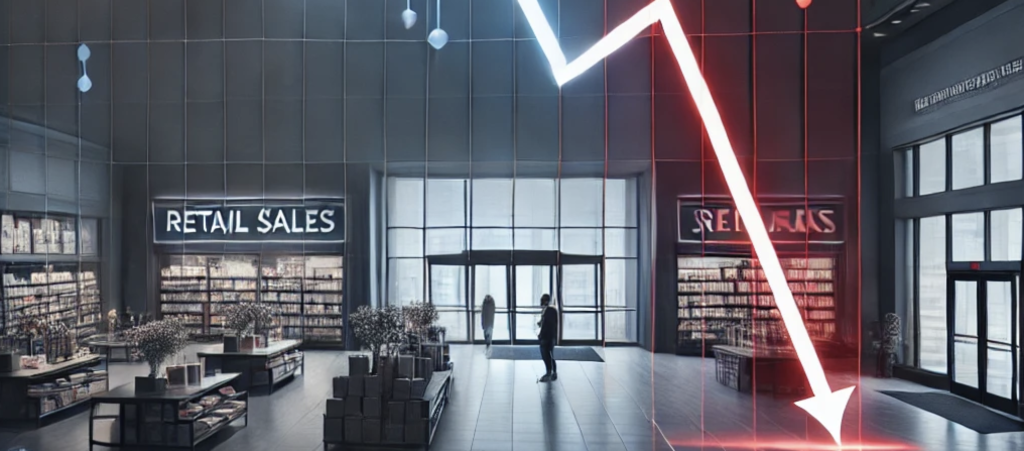
Retail sales in the United States fell sharply in January, marking the largest decline in nearly two years. The drop is largely attributed to extreme winter weather, widespread wildfires, and ongoing vehicle shortages, signaling a potential slowdown in economic growth at the start of the first quarter.
However, this larger-than-expected decline, reported by the Commerce Department on Friday, is unlikely to indicate a major shift in consumer spending patterns, as it follows four consecutive months of strong growth. Additionally, a significant upward revision of December’s sales figures softened the impact of the report.
Economists have pointed out the challenges of adjusting for seasonal fluctuations at the start of the year, a factor that also influenced the January inflation report. Despite the sales dip, they still anticipate that the Federal Reserve will hold off on cutting interest rates until at least the second half of the year. Some economic uncertainty persists due to trade policies, including broad tariffs on imports introduced under President Donald Trump’s administration.
A Temporary Slowdown?
«The drop was dramatic, but several mitigating factors suggest there’s no reason for alarm,» said Robert Frick, corporate economist at Navy Federal Credit Union.
Retail sales declined by 0.9% in January—the steepest drop since March 2023—following a revised 0.7% increase in December, according to the Census Bureau. Economists surveyed by Reuters had predicted a modest 0.1% decline. Despite the monthly drop, retail sales were still up 4.2% year-over-year.
Severe winter storms and freezing temperatures affected large parts of the country, while wildfires devastated neighborhoods in Los Angeles.
«The wildfires in Los Angeles, the second-largest metro area in the U.S., along with extreme winter weather elsewhere, may have limited in-person shopping activity,» noted Jay Hawkins, a senior economist at PNC Financial.
Some analysts also speculated that rising prices and uncertainty surrounding tariffs could have impacted consumer behavior. Preemptive buying ahead of expected tariff hikes had previously boosted retail sales, but consumer sentiment has since weakened. A University of Michigan survey revealed that inflation concerns and trade policy uncertainties contributed to the decline in confidence.
«Some consumers might be confused about tariffs, believing they are already in place and choosing to hold off on purchases,» suggested James Knightley, chief international economist at ING.
A 25% tariff on Mexican and Canadian goods has been delayed until March, while an additional 10% tariff on Chinese imports took effect this month. Meanwhile, Trump has instructed his economic team to draft plans for reciprocal tariffs on countries that impose taxes on U.S. imports.
Market and Federal Reserve Outlook
Stock market reactions remained subdued on Friday, with the U.S. dollar easing against a basket of currencies and Treasury yields declining.
The sales data has done little to alter expectations regarding the Federal Reserve’s monetary policy. The central bank left its benchmark interest rate unchanged at 4.25%-4.50% in January, after cutting it by 100 basis points since September as part of its easing cycle. However, rates remain significantly higher than in 2022 and 2023, when the Fed implemented aggressive hikes to combat inflation.
Breakdown of Retail Sales
The largest decline came from the auto sector, where sales at car dealerships fell 2.8% after rising 0.9% in December. In addition to adverse weather keeping potential buyers away, vehicle shortages may have also played a role.
Other categories also saw declines:
- Sporting goods, hobby, and bookstore sales fell 4.6%.
- Online retail sales dropped 1.9%.
- Building material stores saw a 1.3% decline.
- Furniture, clothing, and electronics sales also experienced notable decreases.
However, restaurants and bars—the only services category included in the report—saw a 0.9% increase, indicating resilient consumer spending on dining out. Higher fuel costs also contributed to a 0.9% rise in gas station sales.
What’s Next for the Economy?
Despite the dip in retail sales, consumer spending remains supported by a strong labor market, steady wage growth, and record-high household wealth driven by home values.
Core retail sales—excluding autos, gasoline, building materials, and food services—fell 0.8% in January after a revised 0.8% increase in December. These figures closely align with the consumer spending component of GDP, which had previously been reported as surging in December.
The Federal Reserve Bank of Atlanta has now adjusted its first-quarter GDP growth estimate down to 2.3% from an earlier 2.9%. The U.S. economy grew at the same 2.3% rate in the last quarter of 2024.
«The underlying strength of the economy remains largely unchanged,» said Tuan Nguyen, U.S. economist at RSM US. «If current trends hold, we should expect a retail sales rebound in the coming months.»


